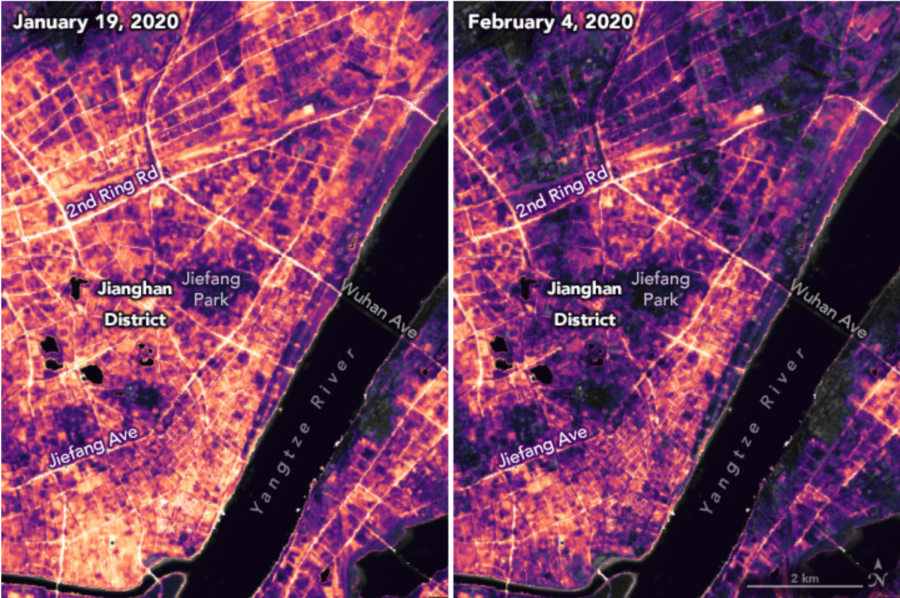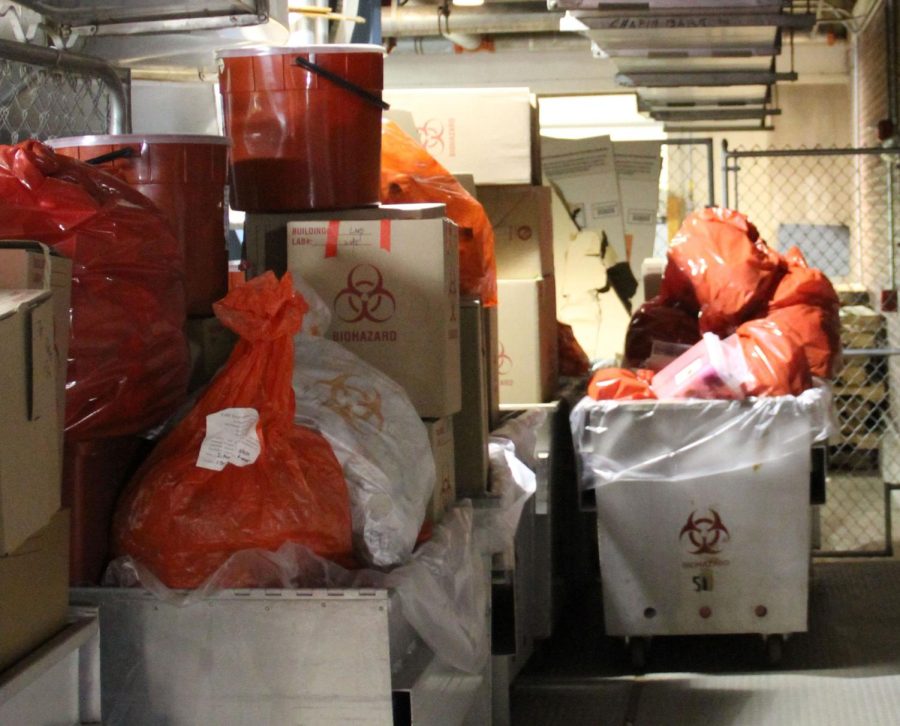The good, the bad and the ugly truth: COVID-19 and its environmental impacts
Reviewing what we know about how the past three years of pandemic impacted the Earth
A surgical mask, which some use to protect against COVID-19, is found during a beach cleanup.
March 16, 2023
In March 2020, the world came to a halt. Lives were turned upside down in a matter of days as businesses shut down and schools closed their doors. Two weeks of what initially seemed like vacation turned into months of quarantine and isolation for individuals across the world. What sounds like the prologue to a dystopian novel was actually the onset of a global pandemic known as coronavirus or COVID-19.
Prompt and decisive health measures were taken in response to the crisis. However, their consequences sustained a profound impact on both human health and the global economy. This has significantly impacted the environment — for better and for worse.
The Good
When the world came to a halt, industry followed suit. Factories closed their doors, employees stashed away their uniforms and global pollution rates began to drop.
The decrease in industrial activity during the pandemic led to a reduction in greenhouse gas (GHG) emissions from factories and power plants. In 2020, The Earth Observatory at the National Aeronautics and Space Administration (NASA) reported that levels of harmful anthropogenic airborne particles, known as aerosols, had dropped significantly in India since the onset of the pandemic. NASA also reported that the economic slowdown correlated to significant decreases in nitrogen dioxide emissions over China, a shift unprecedented in prior years. Similar declines in GHG emissions had been observed and reported across the world. As the world ceased its daily processes, the lessened consumption of fossil fuels slowed the onset of global climate change.

The absence of industrial pollution also led to cleaner water sources, specifically in developing countries that previously dumped domestic and industrial waste into untreated bodies of water. Water bodies that were characteristically turbid or discolored, such as the Bay of Bengal and the ports of Venice, were clearer due to decreased boat activity.
While water and air pollution have visible effects, noise pollution is an invisible threat that has harmful physiological and psychological effects on humans, other living organisms and natural ecosystems. Noise pollution is unnatural sound generated from different human activities, such as construction, and is considered by the World Health Organization to be the third-most hazardous pollution after air and water pollution.
Satellite images taken by NASA during lockdown periods in the city of Wuhan, China, reveal how decreased air travel and road transportation significantly lessened anthropogenic noise pollution in China. Similar results were recorded in Dublin, Ireland, where noise pollution levels decreased due to lockdown procedures, according to Assistant Lecturer at Munster Technological University, Bidroha Basu. These changes were reflected in other major cities across the globe.

Restrictions in transportation and travel have allowed nature to heal itself. With the absence of human activity, popular tourist sites experienced ecological restoration and assimilation with the natural environment. Research findings from Eulogio Soto of Universidad de Valparaíso reported that, with the lack of human waste and disturbance, urban-coastal ecosystems displayed an ability to recover in terms of biodiversity and system functionality, dropping from high levels of turbidity with many aquatic and local species returning.
NASA reported that social distancing and the lack of human disturbance correlated to a decline in the frequency of forest fires in the Southeastern United States, especially on federal lands, which house popular tourist spots such as national parks and wildlife management areas.
The Bad
Although the onset of COVID-19 reduced anthropogenic waste, it fostered an increase in biomedical waste. Biomedical waste relates to chemicals from disinfectants and infectious remnants from non-biodegradable personal protective equipment (PPE), such as masks and gloves. According to Manuel Zambrano-Monserrate of Universidad Espíritu Santo, Hospitals in Wuhan produced an average of 240 metric tons of medical waste per day during the outbreak — much higher in comparison to their previous average of fewer than 50 tons. This waste now poses a major threat to public health and the environment.
Professor Ana María Rule of John Hopkins University stresses that overuse of PPE has resulted in a surge of plastic waste that will take hundreds of years to break down. Smaller and smaller microplastics from plastic waste will accumulate throughout the environment — in the soil, water and air. Invisible and omnipresent, these harmful microplastics will inevitably be consumed by all organisms — including humans.

PPE plastic and medical waste increase the risk of disease transmission to waste workers and thus require special disposal methods, like incineration. Although these disposal methods are designed to prevent contamination and reduce the volume of waste, they still harm the environment by emitting heavy metals, particulate matter and GHG. Disinfectants and surface cleaners also contain particles and chemicals with harmful byproducts. These byproducts, which take many years to degrade, are unable to be processed in water treatment plants and will resultantly accumulate in municipal wastewater across the globe.
Furthermore, pandemic conditions have caused people across the world to turn to online shopping and home delivery as a health-friendly, though unfortunately not environmentally-friendly, alternative. Justine Calma from The Verge claims that this alternative has correlated to an exponential increase in household waste that has waste centers working overtime. This new imbalance disrupts routine municipal waste management, waste recovery and recycling activities, increasing landfill and environmental pollutants worldwide.
The Ugly Truth
The COVID-19 pandemic has had significant environmental impacts, both positive and negative — but we are not in the clear just yet.
With almost all lockdowns ending and economic activity resuming pre-pandemic normalcy, NASA reported that levels of air pollutants, such as nitrogen dioxide, have returned to near normal in China. As typical pollutant levels rebound worldwide, an imminent return to environmental problems awaits us. Global climate change has already resumed its course, with NASA reporting that dust storms and other weather phenomena, induced by high global temperatures, have already begun to offset reductions in aerosol pollution in China.
As a society, it is important to assess our next steps and consider what changes need to be made to improve ourselves and our planet. Not all PPE is necessary, and its overuse does more harm than good. COVID-19 spreads via airborne means, not surfaces, as the virus can only exist on surfaces for about three days. Anna María Rule, an assistant professor in Environmental Health and Engineering at Johns Hopkins recommends that it is more effective and environmentally efficient to consistently wash your hands with soap and water.
Other sustainable environmental management strategies, as recommended by Professor Tanjena Rume of Jahangirnagar University, include sustainable industrialization. This strategy focuses on investing in technologies that reduce emissions and utilizing more renewable energy sources. It also emphasizes the improvement of wastewater treatment and waste recycling while finding ways to reuse these resources. Rume also emphasizes ecological restoration and ecotourism, a measure that requires international cooperation to ensure a more sustainable future. Finally, Rume says that on an individual level, we can all work toward making behavioral changes daily to be more environmentally mindful.















Oracle Integration Cloud (OIC) Training • Sep 14, 2024 at 12:47 am
Thanks for the amazing Blog. Unogeeks is the top Oracle Integration Cloud Training Institute, which provides the best Oracle Integration Cloud (OIC) Training